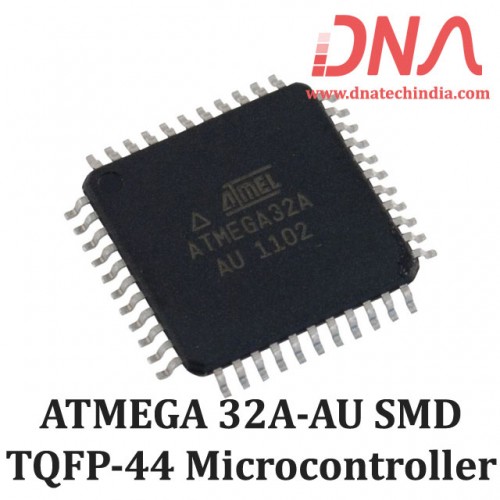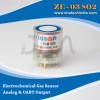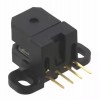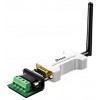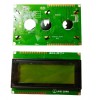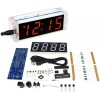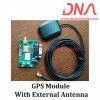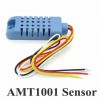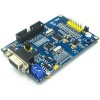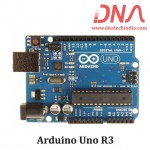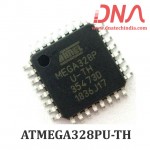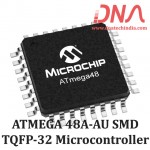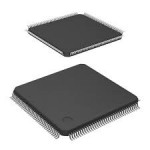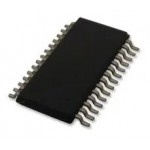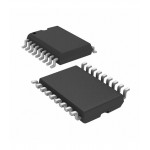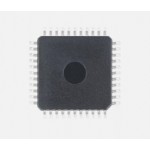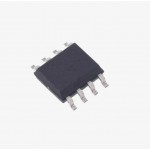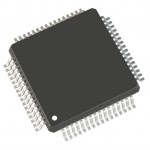Atmega32A-AU SMD Microcontroller
-
Rs.
165.20 (inc GST)
Rs.140.00 + GSTQty :
GST Invoice on all Purchase. So you will be eligible to take input tax credit. |
IF component not in Stock or require more quantity or want to buy in bulk e-mail us your requirements on: dnatechindia "at" gmail.com. |
| Shipping : Due to Covid-19 situation delivery will be affected. Delivery period due to covid-19 issue will be from 4 - 12 days depending upon your location. |
ATmega32A-AU SMD Microcontroller
Atmega32A-AU SMD Microcontroller in TQFP44 package
The ATmega32A-AU comes in SMD TQFP-44 package. ATmega32A-AU Microcontroller is an 8-bit low power, high-performance AVR RISC-based Microcontroller Unit featuring 32kB self-programming flash program memory, 2kB SRAM, 1kB EEPROM, 8 channel 10-bit A/D converter and JTAG interface for on-chip-debug.
ATmega32A-AU SMD Microcontroller achieves 16 MIPS throughput at 16Mz. By executing powerful instructions in a single clock cycle, the ATmega32A achieves through puts approaching 1 MIPS per MHz allowing the system designed to optimize power consumption versus processing speed.
ATmega32A-AU SMD Microcontroller's core combines a rich instruction set with 32 general purpose working registers. All the 32 registers are directly connected to the Arithmetic Logic Unit (ALU), allowing two independent registers to be accessed in one single instruction executed in one clock cycle. The resulting architecture is more code efficient while achieving throughputs up to ten times faster than conventional CISC microcontrollers.
ATmega32A-AU SMD Microcontroller achieves 16 MIPS throughput at 16Mz. By executing powerful instructions in a single clock cycle, the ATmega32A achieves through puts approaching 1 MIPS per MHz allowing the system designed to optimize power consumption versus processing speed.
ATmega32A-AU SMD Microcontroller's core combines a rich instruction set with 32 general purpose working registers. All the 32 registers are directly connected to the Arithmetic Logic Unit (ALU), allowing two independent registers to be accessed in one single instruction executed in one clock cycle. The resulting architecture is more code efficient while achieving throughputs up to ten times faster than conventional CISC microcontrollers.
Features of Atmega32A-AU SMD Microcontroller
- High-performance, Low-power Atmel AVR 8-bit Microcontroller
- Advanced RISC Architecture
- 131 powerful instructions – most single clock cycle execution
- 32 × 8 General Purpose Working Registers + Peripheral Control Registers
- High Endurance Non-volatile Memory segments
- 32K bytes of in-system self-programmable flash program memory
- 1024Bytes EEPROM
- 2Kbytes Internal SRAM
- Write/erase cycles: 10,000 flash/100,000 EEPROM
- Data retention: 20 years at 85°C/100 years at 25°C(1)
- Optional Boot Code Section with Independent Lock Bits
- In-System Programming by On-chip Boot Program
- Programming Lock for Software Security
- JTAG (IEEE std. 1149.1 Compliant) Interface
- Programming of Flash, EEPROM, Fuses, and Lock Bits through the JTAG Interface
- Two 8-bit Timer/Counters with separate prescaler and compare mode
- One 16-bit Timer/Counter with separate prescaler, compare mode, and capture mode
- Real Time Counter with Separate Oscillator
Package Includes
1 x Atmega32A-AU SMD Microcontroller
NEW Products
Product Page : New Products
Winsen ZE03-SO2 GAS Sensor Module
Winsen ZE03-SO2 GAS Sensor ModuleElectrochemical Detection Module ZE03-SO2ZE03-SO2 Gas sensor can be..
Rs.13,216.00 (inc GST)
Rs.11,200.00 + GST
SKU: 1764 | DAB100
Stock: 2
H9700 2 channel Digital Output Small Optical Encoder Module
H9700 2 channel Digital Output Small Optical Encoder ModuleH9700 Unipolar Hall-Effect Sensor ICThe H..
Rs.1,652.00 (inc GST)
Rs.1,400.00 + GST
SKU: 7439 | DAF661
Stock: 3
DTECH IOT5064A RS485 Serial to Ethernet Converter Bluetooth adapter
DTECH IOT5064A RS485 Serial to Ethernet Converter Bluetooth adapterDTECH IOT5064A RS485 Serial to Et..
Rs.6,486.76 (inc GST)
Rs.5,497.25 + GST
SKU: 7466 | DAG852
Stock: 1
JHD 204 20X4 GREEN LCD DISPLAY CHINESSE
JHD 204 20X4 GREEN LCD DISPLAY CHINESSEJHD 204 20X4 GREEN LCD DISPLAY CHINESSEThis is a 20x4 LCD dis..
Rs.402.09 (inc GST)
Rs.340.75 + GST
SKU: 7663 | DAF077
Stock: 5
Have You Seen
Product Page : Have You Seen
4 Digit DIY Electronic Clock kit Multicolor LED time Week Temperature Date Display with Clear case Cover (blue)
4 Digit DIY Electronic Clock kit Multicolor LED time Week Temperature Date Display with Clear case C..
Rs.796.50 (inc GST)
Rs.675.00 + GST
SKU: 7443 | DAF836
Stock: 5
GPS Module With External Antenna
GPS Module With External AntennaThis is a GPS Module with External Antenna. It is based on Skytra S1..
Rs.1,180.00 (inc GST)
Rs.1,000.00 + GST
SKU: 0397 | DAE263
Stock: 0
AMT1001 Resistive Temperature And Humidity Sensor
AMT1001 Resistive Temperature And Humidity SensorAMT1001 Resistive Humidity and Temperature Sensor M..
Rs.335.12 (inc GST)
Rs.284.00 + GST
SKU: 3291 | DAD402
Stock: 9
ADS1256 24bit High Precision ADC STM32F103C8T6 Module
ADS1256 24bit High Precision ADC STM32F103C8T6 ModuleADS1256 24bit High Precision ADC STM32F103C8T6 ..
Rs.5,198.70 (inc GST)
Rs.4,405.67 + GST
SKU: 7630 | DAF121
Stock: 0
Related Products
Arduino Uno R3
Arduino Uno R3Arduino UNOR3 with DIP ATmega328P IC without USB CableThe Arduino Uno is an open sourc..
Rs.486.16 (inc GST)
Rs.412.00 + GST
SKU: 0340 | DAB273
Stock: 8
ATMEGA328P-AU SMD Microcontroller
ATMEGA328P-AU SMD Microcontroller Atmega328 P-Au SMD MicrocontrollerAtmega328P-AU SMD Microcontrolle..
Rs.204.44 (inc GST)
Rs.173.25 + GST
SKU: 0864 | DAB684
Stock: 12
ATMEGA8A Microcontroller
ATMEGA8A MicrocontrollerAtmega8A low power 8-bit microcontrollerATmega8A is a low-power CMOS 8-bit m..
Rs.178.42 (inc GST)
Rs.151.20 + GST
SKU: 2559 | DAC764
Stock: 33
Atmega48A-AU SMD Microcontroller
ATmega48A-AU SMD MicrocontrollerAtmega48A-AU SMD Microcontroller in TQFP32 packageATmega48 microcont..
Rs.236.00 (inc GST)
Rs.200.00 + GST
SKU: 2871 | DAE564
Stock: 1
STM32F429ZIT6 SMD IC
STM32F429ZIT6 SMD ICSTM32F429ZIT6 SMD ICThe STM32F429ZIT6 is a high-performance microcontroller from..
Rs.649.00 (inc GST)
Rs.550.00 + GST
SKU: 5053 | DAG103
Stock: 10
MCP23017-E/SS 16-Bit I/O Expander with Serial Interface IC
MCP23017-E/SS 16-Bit I/O Expander with Serial Interface ICMCP23017-E/SS 16-Bit I/O Expander with Ser..
Rs.178.18 (inc GST)
Rs.151.00 + GST
SKU: 7245 | DAG910
Stock: 0
SSC9512 Current-Resonant Controller IC
SSC9512 Current-Resonant Controller ICSSC9512 Current-Resonant Controller ICThe SSC9512 IC is a curr..
Rs.283.20 (inc GST)
Rs.240.00 + GST
SKU: 7379 | DAF948
Stock: 0
HT1622 44-pin LQFP LCD Controller SMD IC
HT1622 44-pin LQFP LCD Controller SMD ICHT1622 44-pin LQFP LCD Controller SMD ICThe HT1622 is an LCD..
Rs.129.80 (inc GST)
Rs.110.00 + GST
SKU: 7930 | DAG777
Stock: 0
STC8G1K08-36I-SOP8 SMD STC Microcontroller IC
STC8G1K08-36I-SOP8 SMD STC Microcontroller ICSTC8G1K08-36I-SOP8 SMD STC Microcontroller ICThe STC8G1..
Rs.369.93 (inc GST)
Rs.313.50 + GST
SKU: 8134 | DAH638
Stock: 2
STM32F411RET6 Microcontroller 32 Bit 512KB Flash 64LQFP SMD IC
STM32F411RET6 Microcontroller 32 Bit 512KB Flash 64LQFP SMD ICSTM32F411RET6 Microcontroller 32 Bit 5..
Rs.613.43 (inc GST)
Rs.519.86 + GST

